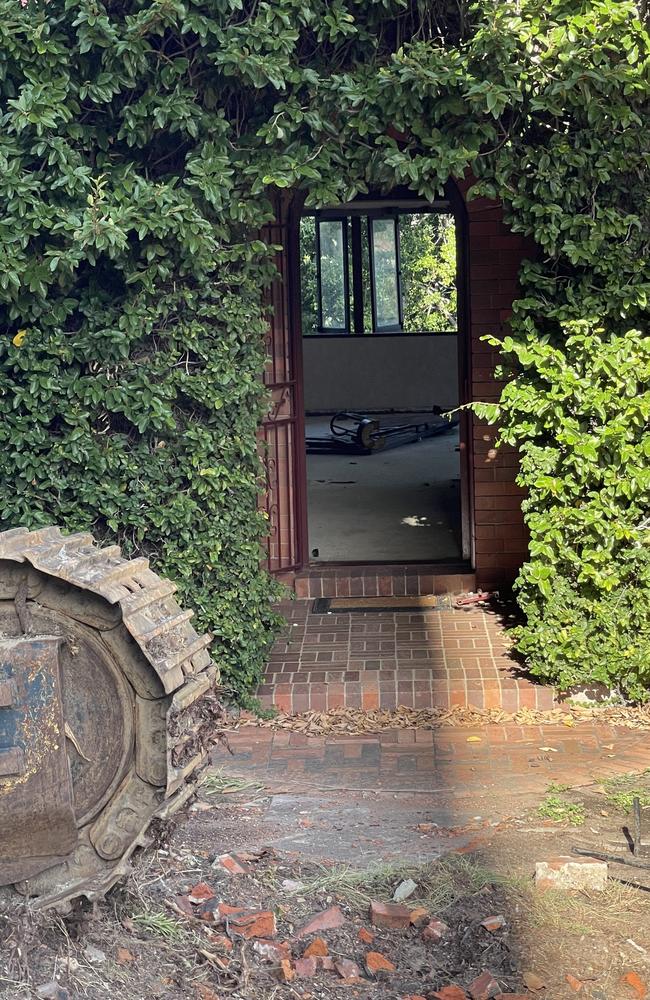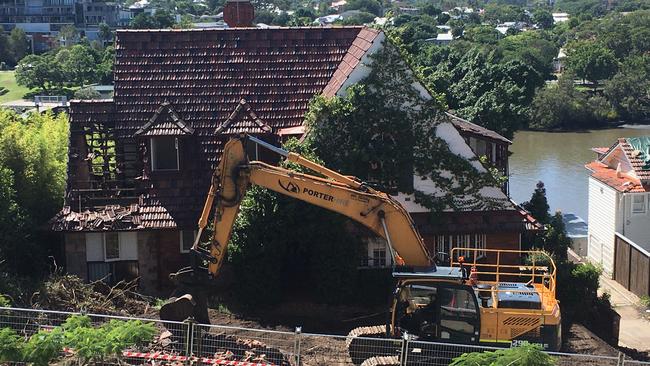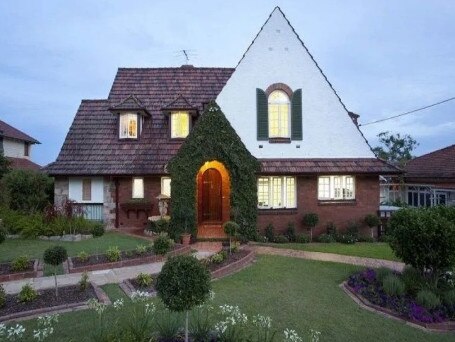Watch now as historic Shingle Inn founder’s house ripped down
After a short reprieve due to asbestos, historic Brisbane home Linden Lea was torn down this afternoon. SEE THE VIDEO
South West
Don't miss out on the headlines from South West. Followed categories will be added to My News.
A landmark riverfront Brisbane home built by the Websters biscuits family in 1937 was finally torn down this afternoon after a reprieve when asbestos was discovered.
An excavator turned up on site at Linden Lea, the last Tudor-style home in Toowong in Brisbane’s inner west, on Tuesday.
But work stopped during the asbestos removal process. Demolition resumed this afternoon, with the property biting the dust after standing for 84 years on a riverfront hilltop street.
Neighbours lodged a heritage application in a last-ditch bid to save Linden Lea and also sought a meeting with the Department of Environment deputy director-general in a bid to get a stop work order.
Toowong Residents’ Group spokeswoman Freya Robertson said they had obtained legal advice from a Queen’s Counsel that Minister Meaghan Scanlon had the power to issue a 60-day stop order, even without a current heritage listing.
But Ms Robertson said they were left frustrated and disappointed when Ms Scanlon wrote to them on March 1 to say the Queensland Heritage Act could not stop authorised development.
“Everyone from the local councillor to the deputy director-general and the deputy lord mayor says their hands are tied. We’ve spoken to everyone we could and they all support us,’’ Ms Robertson said.
“This makes a mockery of the legislation. The State Government is choosing not to act.
“What is the point of having a Queensland Heritage Act if we are not protecting these places?’’
The Webster family built the first of the famous Shingle Inn teahouses a year before commissioning prominent architect Horace Driver to design Linden Lea.
The current owners have been fighting Brisbane City Council for four years after it knocked back their development application.
They applied for a full demolition in June, 2017 which was refused six weeks later by Council.

In September that year they lodged an appeal with the Planning and Environment Court and in April, 2019 the court overturned Council’s refusal and approved demolition.
The matter “slipped through’’ tougher laws aimed at protecting character houses because the demolition application was made just after the law was changed, before it formally came into effect.
The house also is in a low-medium density zone, not a character residential zone, limiting the legal protections on its redevelopment.
“I appreciate your concerns about the impacts of development on the heritage of your local community in Toowong,’’ Ms Scanlon said in her letter.
“Based on advice from the Department of Environment and Science I have decided not to issue a stop order under section 154 of the Queensland Heritage Act 1992.

“While I am satisfied on reasonable grounds that Linden Lea is likely to satisfy the cultural heritage criteria, and that any demolition would destroy or substantially alter the cultural heritage significance of the place, the demolition is authorised by a court order.
“The Act cannot prevent authorised development at a place from proceeding, even if there is a current Queensland Heritage Register application, or if a decision is made by the Queensland Heritage Council to enter a place into the Heritage Register.’’
A Department of Environment spokesman said the situation highlighted the need for proactive community action to identify local and state heritage places to ensure their protection through planning and heritage mechanisms.
“The Linden Lea issue has reinforced Minister Scanlon’s decision to establish a heritage advisory panel to explore options to strengthen the legislative framework to better protect heritage places,’’ he said.
“The heritage advisory panel will include representatives from local government, National Trust of Australia (Queensland) and heritage specialists.’’
Neighbour John Scott, who lodged a Heritage register application on February 10 in a last-ditch bid to save the property, said in his application that Linden Lea was a rare example of inter-war Old English architecture (Tudor or Elizabethan architecture).
“It forms part of a strip of quaint character houses on the river side of Archer St,’’ he said.
“Archer St is home to St Briavels, another inter-war house which has been heritage listed by Council as Local Heritage Place.’’


Mr Scott said James Webster, part of the renowned Websters biscuit family, commissioned Mr Driver in 1937 to design Linden Lea.
“The Webster family had a long and dedicated appreciation for the Old English style of architecture, modelling their private residences and their teahouses, including the Shingle Inn, in this style,’’ he said.
David Webster built the original Shingle Inn the previous year, 1936, in Edward St. It is now a chain of cafes around Brisbane.
Local Councillor James Mackay said he would be deeply disappointed if the house was demolished and went on site today (February 25) to meet neighbours.
“We did not want to see this home demolished and that is why Brisbane City Council refused the demolition application in 2017,’’ Cr Mackay said.
“The applicant would not accept our decision and took the fight to the Planning and Environment Court, where their appeal was successful.
“Council, not accepting of this decision, took this outcome to the Court of Appeal, but the case was thrown out.
“I understand why residents are disappointed, I am too, but at the end of the day our decision to protect this home was overruled by the court on two occasions.’’
Council has no role in the assessment of applications to the Queensland Heritage Register. Only the State Government has the power to issue a stop work order on a court-approved demolition.
Mr Scott said in his heritage submission that the house was the last of its kind in the suburb.
“Linden Lea was later owned by the Bennett family, who owned a number of houses in the Archer St and Glen Rd area,’’ Mr Scott said.

“The Toowong and District Historical Society conducts tours of historical buildings and places in Toowong and includes Linden Lea on these tours.
“If we allow Linden Lea to be demolished then, like Glenolive in St Lucia, we lose an important part of this area’s history to development.
“There are no other examples of this architecture in the Toowong area and the loss of this house would end such a connection.’’
Another neighbour, Ann Kingston-Kerr, said the property had been the subject of a series of court battles since 2017.
“It has enormous value as one of Brisbane riverscape’s most visible and iconic homes and one of its most charming storybook residences,’’ she said.



